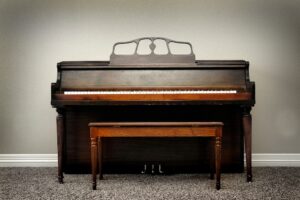March 28, 2024
Moving a Piano in 7 Steps

Though large in size, pianos are delicate instruments that require specialized care and maintenance to keep them in tip-top shape. If you’re planning to relocate across the city, state, or country, the thought of moving one might have you second-guessing your plans.
With the right piano moving company, transferring your piano from one place to the next is simple and stress-free. At Good Stuff Moving, we offer a special service called “furniture-only” moves, which means if you only need to relocate a piano, we’ve got the perfect, cost-effective solution for you!
Of course, if you need your piano, living room, and entire kitchen moved, we also offer an “everything moved” option!
You can get started by requesting a free quote!
Thinking of Moving Your Piano DIY?
We actually wouldn’t recommend it, since pianos can damage more than the walls and floor—they can also injure you in the process.
But we love to share our moving tips, so we’ve compiled a helpful step-by-step guide on moving a piano.
Types of Pianos
Before we dive in, there are several types of pianos, each with unique characteristics and weight to consider.
Grand pianos
These are the largest and most impressive type of piano, with a soundboard up to 9 feet long. They are often used in concert halls and are known for their rich, full sound.
A baby grand piano can weigh around 600 pounds, while a larger grand piano can weigh over 1,000 pounds or more.
Upright pianos
Also known as vertical pianos, upright pianos are the most common type of piano found in homes and schools. They are compact and take up less space than grand pianos.
An average upright piano can weigh up to 500 pounds.
Electronic pianos
Electronic pianos use digital technology to mimic the sound and feel of an acoustic piano. They’re often more affordable than traditional pianos and have the added advantage of being able to adjust volume and play with headphones.
A full-sized digital piano usually weighs between 100 and 300 pounds, while a compact or portable model can weigh as little as 20 pounds.
Remember that a piano’s weight can make it difficult to move, even for experienced movers. When moving a piano, you must take the necessary precautions to ensure that the instrument is transported safely and securely.
How To Move a Piano
Check out these pro tips on moving a piano. Remember, if you need support, our crew is ready to help!
Step 1: Measure Your Piano and the Surrounding Area
Measure all the doorways, hallways, and staircases to ensure enough clearance for your piano.
Be sure to clear a pathway for the move, including any chairs, tables, or even picture frames on the walls that may become unnecessary obstacles.
Step 2: Get the Gear
Make sure to have all the necessary equipment, such as
- Lifting Straps
- Moving blankets
- Moving tape
- Bubble wrap
- Heavy-duty furniture dollies with soft, non-marking wheels
Step 3: Prepare Your Piano for the Move
Start by removing all the loose parts, such as the music stand, lid, and pedals, and wrap them in moving blankets or bubble wrap.
Next, wrap the entire piano in moving blankets and secure them with tape or straps.
Finally, cover the piano with a tarp or plastic sheet to protect it from dust and moisture.
Step 4: Position the Dollies
With others’ help, you’ll need to position the dollies on either side of the piano. Professional movers will lift it using the lifting straps, place the piano on the dollies, and secure it with straps.
It’s important to remember that an experienced piano moving company knows how to lift, support, and position a piano to ensure the instrument doesn’t become damaged—or the people doing the heavy lifting.
Moving a piano can cause serious injury, so you should leave it to the pro!
Step 5: Move the Piano
Push the dollies slowly and carefully, watching out for obstacles or uneven surfaces. If you encounter stairs or steps, get additional help to lift the piano up or down them.
Be sure your moving truck has a secure and sturdy ramp to load the piano for transport.
Need help? We’ve got your piano moving needs covered!
Step 6: Secure the Piano
Once the piano is loaded onto the truck, secure it with additional straps or ropes to prevent it from moving during transit.
Step 7: Unload the Piano
After you’ve arrived at your destination, carefully unload the piano from the dollies and remove the protective coverings.
Next, reattach all the loose parts, such as the music stand, lid, and pedals.
Where Can I Find Piano Movers Near Me?
Whether you live in St. Paul, Minneapolis, or a suburb in between, Good Stuff Moving can relocate your furniture, appliances, and belongings more affordably and professionally!
Our crew has moved many pianos, which means we know the tools and techniques to effectively carry out the task. Whether you need to move a piano or want to pack and relocate the entire inside of your home, we do it all so you can look forward to settling into your new community.
How Much Does It Cost to Move a Piano?
The answer to this question depends on a few factors, including the size and weight of the instrument and the equipment needed. It can also depend on whether you want to move just your piano or other belongings.
For a fast, accurate answer, we recommend you fill out our “request a quote” form! Our team will then provide you with a comprehensive cost breakdown, so you know what to expect and can confidently plan your upcoming move.
To get started, request your quote today—always free with no obligations!






